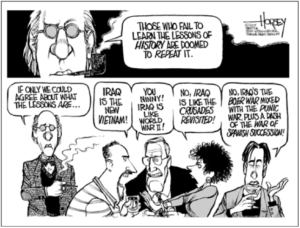Zarefsky, David. “Four Senses of Rhetorical History.” Doing Rhetorical History: Concepts and Cases. Ed. Kathleen J. Turner. University of Alabama Press, 1998. P. 19-32.
Zarefsky claims that “the heart of our problem is sloppiness in the professional discourse, and perhaps in the thought, of rhetorical historians” (19). He argues that the distinction between history and criticism does not matter. Within this camp, history is concerned with “facts and chronicle” and criticism with “interpretation and judgment” (20). Together, this approach analyzes biographical information, public oration, and effectiveness through empirical measures (20), which is so broad that nearly anything can be made to fit. A second distinction that doesn’t matter, according to Zarefsky, is between history and theory, mainly that history is noninterpretive. Ultimately, neither distinction addresses the “so what” question and therefore doesn’t matter.
 On the other hand, distinctions that do matter point to four senses evolving from the term rhetorical history. First, the history of rhetoric is concerned with the development of effective discourse throughout the years and within various cultural contexts. This distinction, the least problematic of the four, connects in many ways with the history of ideas and is responsible for the reclamation of the sophist tradition among other important aspects of the rhetorical canon. Secondly, “‘the rhetoric of history is concerned with the tropes, arguments, and other devices of language used to write history and to persuade audiences'” (Megillah and McCloskey qtd. on 28). This distinction has ideological implications as scholars argue both about and from history. The third and fourth senses are derived from what used to be known as the history of public address. The third sense, having undergone the most change, is the historical study of rhetorical events, which can be approached from a few angles: rhetorical discourse as a force in history or as an index or mirror of history; a focus on key arguments and terms; and discourse patterns that suggest a rhetorical trajectory (29). Finally and most elusively, the study of historical events from a rhetorical perspective “begins with the assumption that the rhetorical historical has the same subject matter as any other historian: ‘human life in all its totality and multiplicity'” (30). The only difference then rests on perspective, with the rhetorical historian focused on the perspective of discourse used persuasively.
On the other hand, distinctions that do matter point to four senses evolving from the term rhetorical history. First, the history of rhetoric is concerned with the development of effective discourse throughout the years and within various cultural contexts. This distinction, the least problematic of the four, connects in many ways with the history of ideas and is responsible for the reclamation of the sophist tradition among other important aspects of the rhetorical canon. Secondly, “‘the rhetoric of history is concerned with the tropes, arguments, and other devices of language used to write history and to persuade audiences'” (Megillah and McCloskey qtd. on 28). This distinction has ideological implications as scholars argue both about and from history. The third and fourth senses are derived from what used to be known as the history of public address. The third sense, having undergone the most change, is the historical study of rhetorical events, which can be approached from a few angles: rhetorical discourse as a force in history or as an index or mirror of history; a focus on key arguments and terms; and discourse patterns that suggest a rhetorical trajectory (29). Finally and most elusively, the study of historical events from a rhetorical perspective “begins with the assumption that the rhetorical historical has the same subject matter as any other historian: ‘human life in all its totality and multiplicity'” (30). The only difference then rests on perspective, with the rhetorical historian focused on the perspective of discourse used persuasively.
The common thread throughout not only Zarefsky’s argument but many from within English studies is that our field is multidisciplinary. In fact, it is because the nature of our field is such that we rhetoricians should do history. Zarefsky highlights, with each of his four senses of rhetorical history, key research questions that point to methodologies and modes of inquiry relevant to each distinction. My personal research agenda requires that I ask where rhetoric of identity specifically fits. Within which sense, if any, does its history lie? I think the fourth sense, the study of historical events from a rhetorical perspective, would provide a space for historical inquiry with the specific agenda of locating rhetoric of identity. Perhaps, however, identification rhetoric dwells within the scope of any or all four senses.